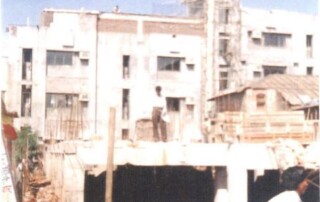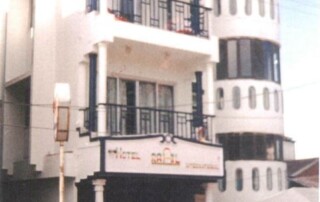Introduction
The vast plateau of Mahabaleshwar Plateau stands tall — 4,500 feet above sea level — in the midst of the dense forests of the Sahyadri Mountains, commanding magnificent views of the Sahyadri slopes, dazzlingly green with moss and grass.
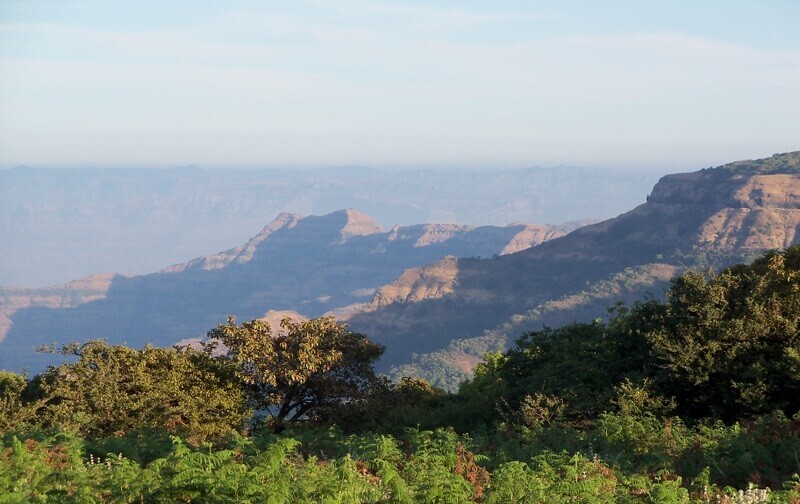
Sahyadri mountains & slopes with its dazzling greens – Credit: David Cardoz
One hundred kilometres from Pune and 260 kilometres from Mumbai, the Mahabaleshwar plateau is known for its lush forests, diverse wildlife, cool climate, and ancient temples. It is also revered for being the source of five rivers — the Krishna, Koyana, Venna, Savitri, and Gayatri.
The evergreen forests of the Mahabaleshwar plateau are beautiful all year round, but in October, after the south-west monsoon recedes, the plateau becomes a valley of wild flowers. The wild arrowroot lily, wild rose and sweet pea fills every glade. Fern, of which there are 55 varieties, some rare, are everywhere in leaf. Herbs and medicinal plants grow in abundance. Strawberries, raspberries, shikakai, and honey are everywhere. Mahabaleshwar produces 85 per cent of the country’s total strawberry crop.
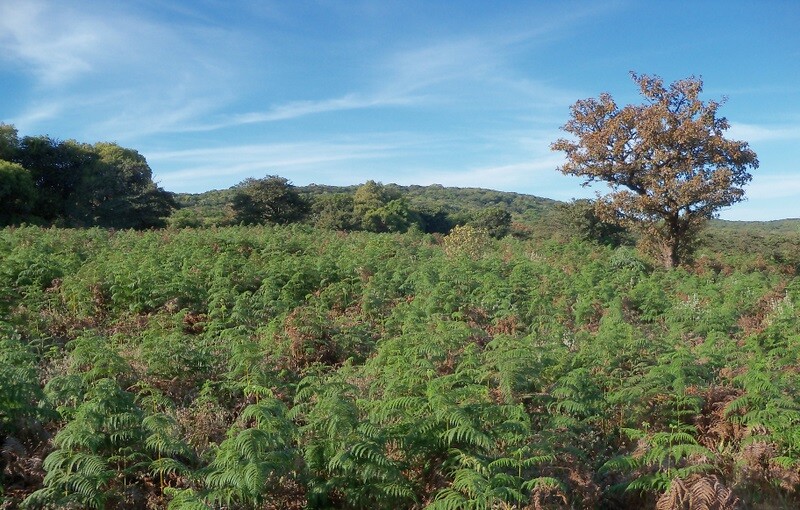
Fern forest in Brahmaaranya Credit: David Cardoz
The profusion of flora on the plateau provides to an equally varied fauna: wild animals such as tigers panthers, Indian foxes, Indian Gaur, barking deer, mouse deer, wild cats, giant Indian squirrels, civet cats; wild birds such as bulbuls, spur-fowls, jungle fowls, birds of paradise, blackbirds and golden oriels, and wild reptiles such as nag, phursa, ghonas, and manyar. Rich in biodiversity, the area attracts numerous scientists.
 |
 |
|---|---|
| A herd of Indian Gaur spotted during the pandemic | The flowering of Habenaria Panchganiensis during monsoons is endemic to Panchgani Tableland |
 |
 |
| Malabar Lark spotted on the ambral plateau | Euphorbia panchganiensis endemic to Panchgani Tableland |
The plateau is also home to the twin hill stations of Mahabaleshwar and Panchgani, which are a major tourist attraction and famous for their scenic beauty, exotic fruits, and residential educational institutions.
The town of Mahabaleshwar is situated on a Sahyadri spur and has spectacular views.
![]()
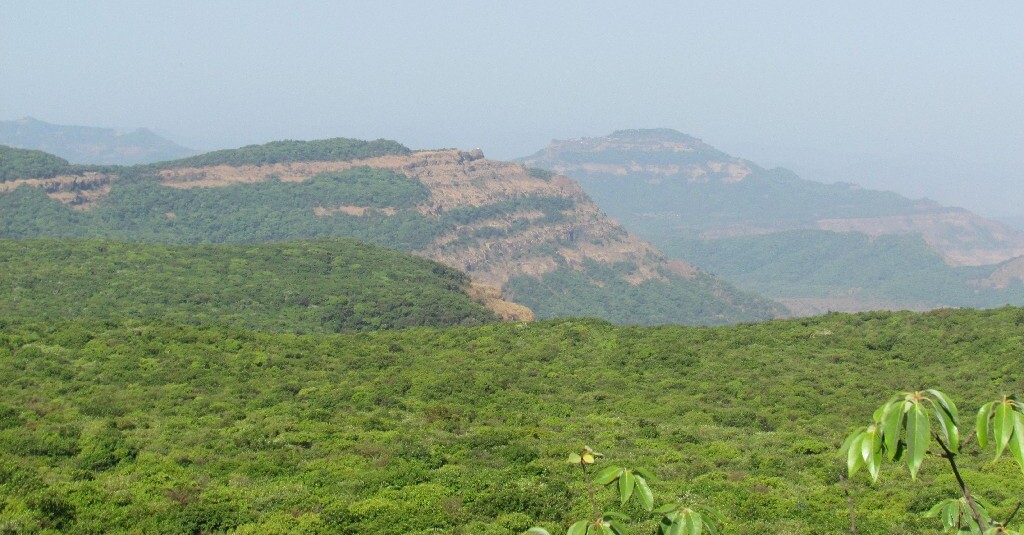
View of forest crown seen from Connaught Peak Credit: BEAG Archive
The town of Panchgani, also graced with magnificent views, is only 18 kilometres west of Mahabaleshwar but is quite a different town. Being in the rain shadow, it has quite a different ecology and a very different climate from Mahabaleshwar. Cool and comparatively dry, it has many residential educational institutions.
BEAG’s campaign for the conservation of this ecological paradise began in 1983. BEAG won a major victory when it succeeded in having the region declared an Eco-Sensitive Zone (ESZ) by the Government of India, making Mahabaleshwar and Panchgani the first hill stations in India to be given such a designation. The declaration of the Mahabaleshwar, Panchgani and the surrounding areas as an ESZ brought them under the protection of the Environment *(Protection) Act of 1986 (EPA) with its regulated provisions.
Discovery of the Hill Stations
Mahabaleshwar is the largest hill station in the state of Maharashtra in India.
Mahabaleshwar served as the summer capital of Bombay province during the British Raj, but it has a long history and was ruled by a succession of kings.
In the 13th century, King Singhan of Deogiri built the Mahabaleshwar temple.
In 1828, the British acquired control of Mahabaleshwar from the king of Satara.
The British Governor of Bombay, Sir J Malcolm, established a convalescent hospital in Mahabaleshwar for British soldiers and a Governor’s residence for himself. Other colonial structures came up soon after, among them the famous Christ Church,and Frere Hall.
Unlike Mahabaleshwar, Panchgani was founded not under government patronage but by private enterprise. Due to its salubrious climate, it is an educational centre with a large number of residential schools. The architectural style of its buildings is also distinct from Mahabaleshwar’s, with a distinct character and charm all its own.
How the Plateaus came to be declared India’s first Eco-Sensitive Zone (ESZ)
BEAG had been active in the Mahabaleshwar and Panchgani area since 1983. In 1985, the Government of Maharashtra formulated the first Regional Plan for the Mahabaleshwar Panchgani region, which governed the non-municipal areas, as well as the Development Plans (including the Development Control Regulations), which governed the towns of Mahabaleshwar and Panchgani.
In May 1997, finding that severe environmental and heritage site degradation had resulted from willful violations of the Development Plans regulations, BEAG filed a writ petition (WP 2754/1997) in the Bombay High Court.
In response to BEAG’s writ petition, the High Court appointed a committee to investigate the violations. The committee submitted a Report with than 1,000 violations.
It was a serious situation. The High Court had issued several directives ordering compliance with the law and the regulations, but local developers and property-owners had great influence, if not control, over the municipalities. In fact, many municipal councilors had themselves built hotels that were prima face illegal and had been putting a great deal of pressure on the state government to amend the regulations and change the zoning of green zones to permit more construction. While the High Court could ensure adherence to the regulations, it would be helpless if the regulations themselves were changed.
Hoping that the declaration of the plateau as an Eco-Sensitive Zone (ESZ) would forestall all these pressures and bring the region under the stringent controls of the Environment (Protection) Act of 1986, BEAG presented an ESZ proposal to the Government of India’s Environment Minister in November 1998.
The Government of Maharashtra was also concerned about the fragility of the Mahabalaleshwar plateau’s ecology. An environmental assessment conducted by a committee it had appointed said conclusively in its Report in 2000 that without protection, the plateau’s ecology would be irreparably damaged.
The Ministry of Environment, Forests and Climate Change’s committee on the designation of ecologically sensitive areas in India also urged the Government of India to accord special protection to areas identified as ecologically sensitive or fragile.
On July 25, 2000, after two years of ceaseless campaigning by BEAG, the Government of India issued a draft notification announcing its intention to declare Mahabaleshwar and Panchgani Region an Eco-Sensitive Zone, and on January 17, 2001, the final notification under the Environment (Protection) Act, 1986, was published by the Ministry of Environment and Forest, Government of India, officially declaring the Mahabaleshwar and Panchgani Region an Eco-Sensitive Zone.
Thus, Mahabaleshwar and Panchgani became the first hill stations in India to be so designated, a culmination of BEAG’s efforts since 1983, and the beginning of a new era of environmental protection.
The entire plateau encompassing the two municipal areas of Mahabaleshwar and Panchgani along with 60 villages was declared as an ESZ in 2001. The total area of the Mahabaleshwar Panchgani ESZ (MPESZ) is 237 square kilometres.
The MPESZ boundary is a Regional Plan boundary, not an ecological boundary. The ecological boundary extends on all sides — all the way to Raigad in the north-west and to Ratnagiri in the south-west. But since it would have been difficult for three collectors of three separate districts to administer the ESZ, only the Satara district is included in the MPESZ.
In its ESZ notification, the Government of India regulated construction (height of buildings, maximum number of storeys), locations where industries may be permitted, types of industries permitted, tourism facilities (which were to also be detailed in a Tourism Master Plan), quarrying and mining, felling of trees, construction on hill slopes, effluent disposal, disposal of solid waste, use of plastic, extraction of ground water, and so on. It also provides specification of conversion of land from green uses (forests, horticulture areas, other green areas) to non-green uses. The ESZ notification also has specific provisions for the conservation of heritage sites, both natural and man-made.
Monitoring Committee
The Eco-Sensitive Zone (ESZ) notification of January 2001 stipulated that a High-Level Monitoring Committee (HLMC) be constituted to oversee adherence to the provisions of the notification. Nine months later, the Environment Ministry had set up the HLMC, which included BEAG members.
The HLMC became a central authority coordinating the activities of several government departments — Revenue, Forest, Public works, Police — and the municipalities of Mahabaleshwar and Panchgani, which had often worked without coordination and sometimes at cross purposes.
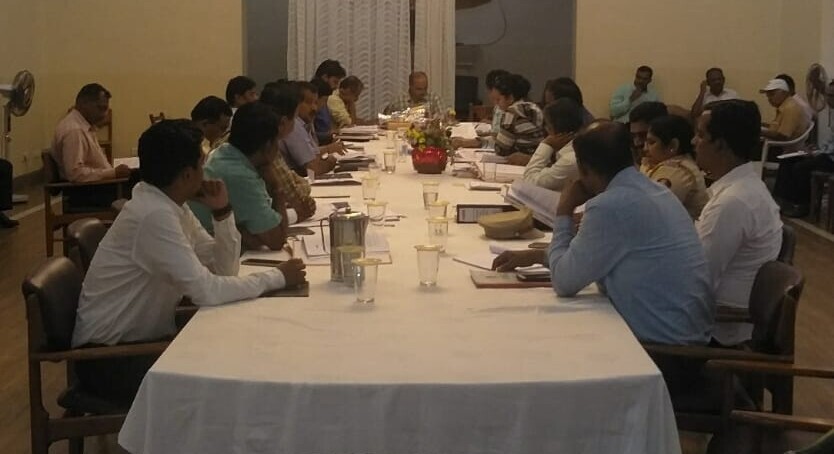
HLMC meeting chaired by Dr Ankur Patwadhan in progress Credit: BEAG Archive
It is also now a citizens’ forum where residents environmental complaints can be promptly dealt with.
Longer-term issues taken up by the HLMC included the finalization of Zonal Master Plan, and the initiation of plans for traffic management, solid waste disposal, and plastics disposal, as well as the survey of the bio-diversity in the MPESZ.
Monitoring Committee Minutes Archive & Current
The first HLMC was constituted under the chairmanship of Shri Jamsheed Kanga (2001-2005) The Committee held 14 Meetings
The second HLMC was reconstituted under the chairmanship of Shri B.N.Bahadur. After Shri B N Bahadur’s resignation, the same committee was once again re-constituted under the chairmanship of Shri Dev Mehta (2008-2010). The Committee held 5 Meetings
The third HLMC was reconstituted once again under the chairmanship of Shri Dev Mehta (2010-2012). The Committee held 11 Meetings and also submitted a report to the Ministry of Environment, Forest and Climate Change.
The fourth HLMC was reconstituted under the chairmanship of Shri Karandikar (2014 – 2016). The Committee held 6 Meetings
The fifth HLMC was reconstituted under the chairmanship of Dr Ankur Patwardhan (2017 – 2020). The Committee held 8 Meetings
Zonal Master Plan
The Government of India’s Eco-Sensitive Zone (ESZ) notification of 2001 mandates the Government of Maharashtra to prepare a Zonal Master plan for the entire ESZ and submit it to the Government of India’s Ministry of Environment and Forests for approval within two years of the date of ESZ notification’s publication.
The ESZ notification states that the Zonal Master Plan prepared by the Government of Maharashtra needs to include the following plans: a Sub-Zonal Master Plan for the region outside the municipal limits of Mahabaleshwar and Panchgani, a Sub-Zonal Master Plan for the municipal area of Mahabaleshwar, a Sub-Zonal Master Plan for the municipal area of Panchgani, a Tourism Master Plan for the region, and a Heritage Plan for conservation of important natural and man-made heritage sites for the region.
Regional Plan / Sub Zonal Master Plan for Non-Municipal Areas (2002 – 2022)
The ESZ notification of 2001 directs the Government of Maharashtra to prepare a Sub Zonal Master Plan (SZMP) for the region outside the municipal limits of Mahableshwar and Panchgani
As the Mahabaleshwar and Panchgani Regional Plan (1984-2001), sanctioned in 1985, then in effect, was already being revised as per the provisions of the Maharashtra Regional and Town Planning Act, 1966 (MRTP Act) which requires plans to be renewed every 20 years, the Government of Maharashtra simply continued with the ongoing revision process, while ensuring that it met the requirements of the ESZ notification
In order to formulate the Regional Plan/SZMP, the Government of Maharashtra, in 2002, constituted a Regional Planning Board as per the provisions of the Maharashtra Regional and Town Planning Act, 1966 (MRTP Act), and tasked it with the responsibility of preparing and submitting the mandatory rural Land Use Plan and the Development Control Regulations (DCRs).
The Regional Planning Board set up sub-committees to carry out surveys and prepare reports that would be used to formulate the Regional Plan/SZMP and make recommendations.
In January 2002, the Regional Planning Board held a meeting with the High-Level Monitoring Committee, then under the chairmanship of Shri. Jamsheed Kanga, which led to the constitution of four special sub-committees — Land Use, Environment, Tourism and Technical.
BEAG was a member of two of the Regional Planning Board sub-committees: the Land Use Sub-Committee and the Environmental Sub-Committee.
After a great deal of effort by BEAG, the extensive and exhaustive list of the Land Use principles and DCRs were accepted by the Regional Planning Board. However, they were not fully incorporated into the Draft Regional Plan/SZMP that was notified in 2005 for public suggestion.
Through the various provisions of MRTP Act, 1966, BEAG continued to make representations before various authorities to ensure that the provisions of the Final Regional Plan/SZMP were in consonance with the ESZ notification. For example, BEAG ensured that the definition of parks in the Final Regional Plan/SZMP did not include amusement and water parks; Conservation Zones included origins of waterfalls; various agro-based industries in the Green Zone were granted permission to function; DCRs were followed for bed-and-breakfast schemes; and surveyed Vansadrushya (deemed forest) areas were included in the Zonal Master Plan.
BEAG was also actively involved with the HLMC under the chairmanship of Shri Dev Mehta and was instrumental in ensuring that the Regional Plan/SZMP submitted for approval to the Ministry of Environment, Forest and Climate Change was in compliance with the ESZ notification.
The Final Regional Plan/SZMP for the ESZ was published by the Government of Maharashtra on August 7, 2015.
However, the document published in 2015 was essentially the 2005 Draft SZMP/Regional Plan as a 30-page list of the modifications and amendments made between 2007 and 2011 to the 2005 Draft first by the Government of Maharashtra under the MRTP Act and later by the Ministry of Environment, Forest and Climate Change.
BEAG continued to follow up with the state government to ensure that the Final Regional Plan/SZMP Report and DCRs incorporated all the modifications within the body of the document. A 30-page list of modifications would be hard for anyone to follow.
In fact, BEAG spent weeks laboriously going over each modification in the 30-page list of modifications and inserting each one into the appropriate section and clause of the 350-page Final Regional Plan/SZMP document. It submitted this consolidated document to the Government of Maharashtra in 2015.
BEAG then continued to follow up with the state government and the HLMC to publish the consolidated document.
In 2020, the Government of Maharashtra finally published the consolidated document as the Final Regional Plan/SZMP on its website for public access.
Conservation Zones
Since the MPESZ consists of several plateaus and the ESZ notification had stipulated that particular tracts of land should be designated as being exclusive niche biodiversity spots, the Regional Planning Board during the preparation of the Regional Plan introduced a new classification: the Conservation Zone.
BEAG was instrumental in conducting surveys of 14 sites peaks and plateaus within the MPESZ in 2004 that required special conservation, and the Government of Maharashtra earmarked all of these sites as Conservation Zones, even formulating provisions in the DCRs for their protection and conservation.
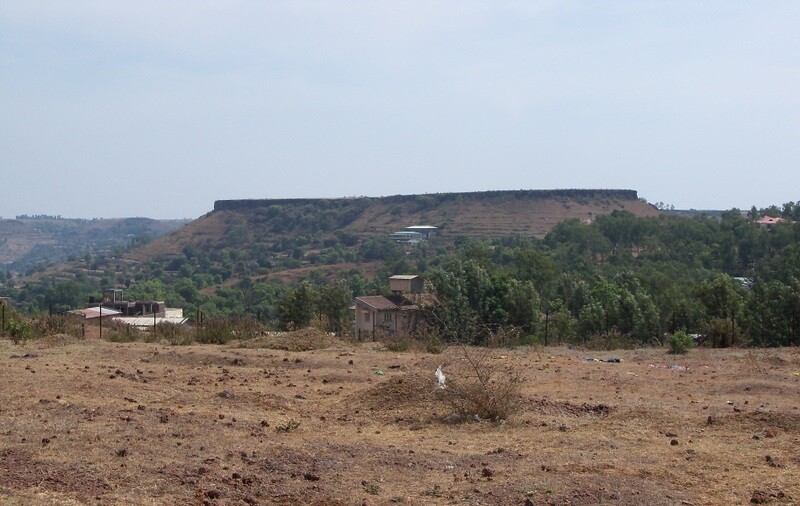
Khingar plateau seen Panchgani Tableland Credit : David Cardoz
.
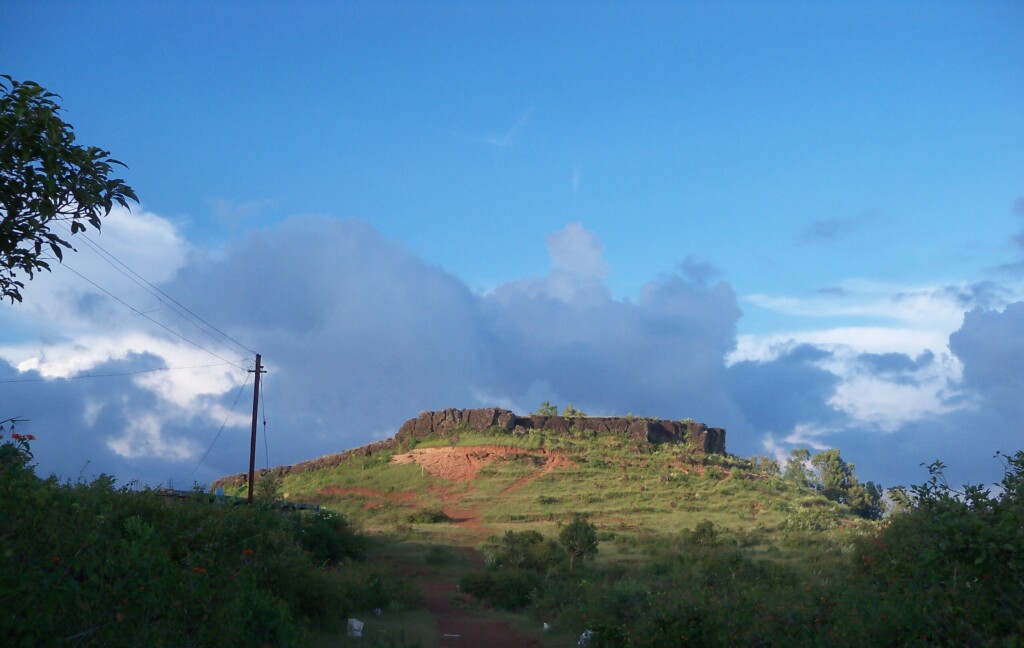
Ambral plateau Credit : David Cardoz
Additionally, BEAG also identified 12 sites where waterfalls originated as sites of valuable natural heritage, as stipulated by the ESZ notification. The HLMC under the chairmanship of Shri Dev Mehta recommended the same sites to the Ministry of Environment, Forest and Climate Change, a recommendation that was approved by the Ministry and accepted by the Government of Maharashtra. Origins of waterfalls are now protected under Conservation Zone.
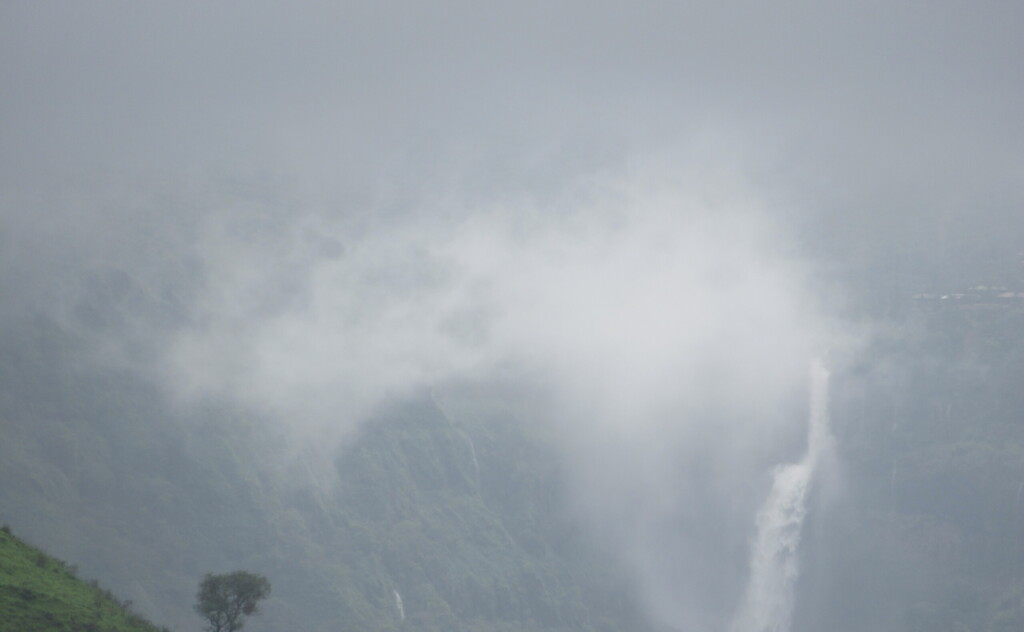
Waterfall seen from the Mahabaleshwar Satara Road Credit : David Cardoz
Thus, the Government of Maharashtra’s Regional SZMP for Mahabaleshwar and Panchgani Region set a precedent in the state by introducing the concept of the Conservation Zone for niche ecological areas.
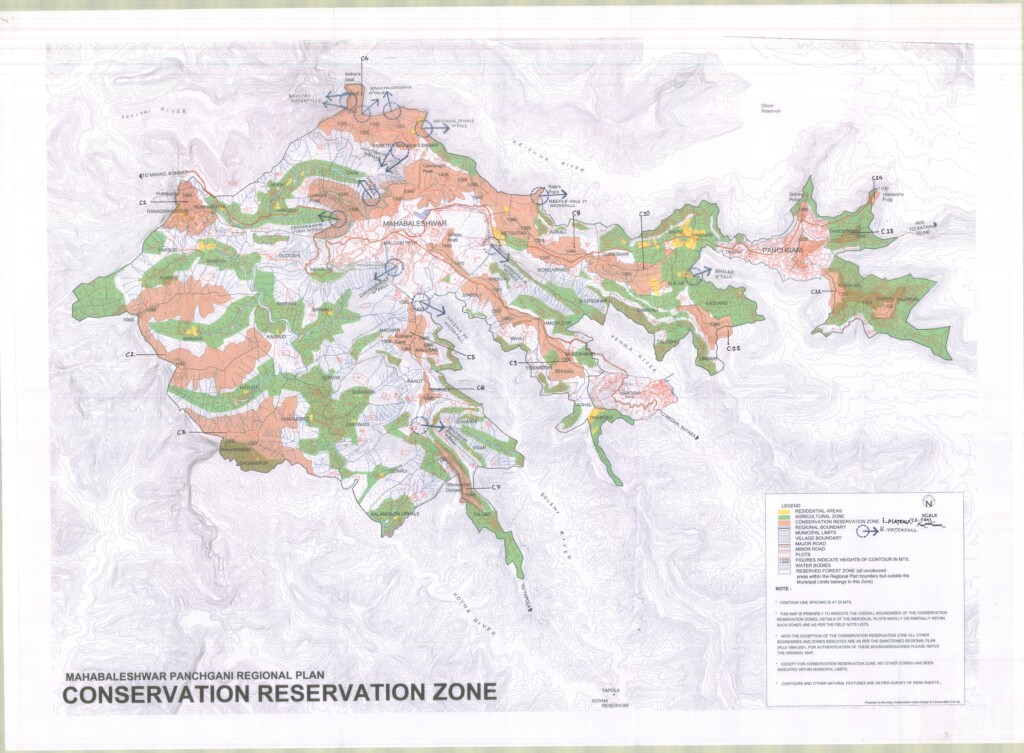
Conservation Zone Map Credit : David Cardoz
Development Plans or the Sub Zonal Master Plans for the Municipal Towns
At the time of the 2001 ESZ notification, Mahabaleshwar was being governed by the Final Development Plan of 1985 (which included the Development Control Rules) while Panchgani, was under the governance of the Final Development Plan of 1988.
When the Government of India published the ESZ declaration in 2001, it directed the Government of Maharashtra to create separate Sub Zonal Master Plans for the municipal areas of Mahabaleshwar and Panchgani, which are commonly still referred to as Development Plans.
Mahabaleshwar Development Plan
On July 30, 2009, the Government of Maharashtra published the SZMP /Draft Development Plan for Mahabaleshwar, along with its DCRs along with Sector 1 and Sector 2 Plan for public suggestion and objection.
BEAG had been filing suggestions and objections under the MRTP Act during the entire process of the Mahabaleshwar SZMP Development Plan formulation to ensure that the policies and regulations in the plan were consonant with the ESZ notification.
In accordance with procedures stipulated by the MRTP Act, the Government of Maharashtra sanctioned part of the SZMP /Draft Development Plan for Mahabaleshwar as the Sanctioned Modifications portion of the Plan and published it as the final plan on March 28, 2013. Shortly after, on October 9, 2013, it published the Excluded Part or substantial modifications portion.
On March 1, 2016, the Government of Maharashtra finalized the SZMP / Development Plan for Mahabaleshwar and forwarded it to the Ministry of Environment, Forest and Climate Change for approval, as mandated by the ESZ notification. The final SZMP Development Plan for Mahabaleshwar will be published by the Government of Maharashtra after it receives the Ministry’s approval.
BEAG continues to follow up with the Government of India, the Government of Maharashtra and the High-Level Monitoring Committee (HLMC) to expedite the finalization of the SZMP for Mahabaleshwar and its subsequent final notification, as mandated by the 2001 ESZ Notification.
Panchgani Development Plan
On May 13, 2010, the Government of Maharashtra published the Draft Development Plan for Panchgani, along with its DCRs and Plans, for public suggestion and objection.
BEAG had been filing suggestions and objections under the MRTP Act during the entire process of the Panchgani SZMP Development Plan formulation to ensure that the policies and regulations in the plan were in compliance with the ESZ notification.
In accordance with procedures stipulated by the MRTP Act, the Government of Maharashtra sanctioned part of the SZMP / Draft Development Plan for Panchgani as the Sanctioned Modifications portion of the Plan and published it as the final plan on June 4, 2012. Shortly after, on October 9, 2013, it published the Excluded Part or substantial modifications portion.
On August 6, 2015, the Government of Maharashtra finalized the SZMP / Development Plan for Panchgani and forwarded it to the Ministry of Environment, Forest and Climate Change for approval, as mandated by the ESZ notification. The final SZMP / Development Plan for Panchgani will be published after it receives the Ministry’s approval.
BEAG continues to follow-up with the Government of India, the Government of Maharashtra and the HLMC to expedite the finalization of the Sub Zonal Master Plan for Panchgani and its subsequent final notification, as mandated by the 2001 ESZ Notification.
Other Sub-Zonal Plans
The ESZ notification states that the Zonal Master Plan prepared by the Government of Maharashtra needs to include a Tourism Master Plan for the region, and a Heritage Plan for conservation of important natural and man-made heritage sites for the region.
The Tourism Master Plan is still being formulated.
The Heritage Plan is incorporated into the SZMP for the region and the SZMPs for the development of the municipal areas of Mahabaleshwar and Panchgani.
Regional Plan and DP Archive
BEAG has been in the forefront of the campaign to frame environmentally compatible regulations for the Mahableshwar Panchgani region since 1983.
The Plateau was under tremendous pressure of ever-increasing tourist traffic which was straining the resources, amenities and civic facilities of the two hill stations.
In 1983, the Government of Maharashtra had become seriously concerned that the unplanned development and construction would gravely damage the ecology and environment of the plateau and aggravate the ongoing deforestation.
The Government of Maharashtra therefore constituted a Regional Planning Board under the provisions of Maharashtra Regional and Town Planning Act, 1966 (MRTP Act) to draw a separate Regional Plan for the Mahabaleshwar Panchgani Region with the prime objectives of restoration, conservation and protection of the ecological order and development of a nature reserve and for the purpose of regulating the use of land in this Region.
When the Mahabaleshwar-Panchgani Regional Planning Board was constituted in 1983, one of its members was a BEAG trustee.
In July 1984, the Government of Maharashtra published the Draft Regional Plan for the Mahableshwar-Panchgani Region for public suggestions and objections. Several of BEAG’s key suggestions were incorporated into the plan, including one to earmark 90 percent of the Mahabaleshwar plateau as a green zone/forest zone.
The final Regional Plan with Report (1984-2001) was sanctioned on December 30, 1985.
Mahabaleshwar Development Plan Archive
In May 1983, the Mahabaleshwar Municipal Council submitted the Draft Development Plan of Mahabaleshwar (including the Development Control Rules) to the Government of Maharashtra for approval.
In 1984, BEAG intervened by filing suggestions and objections and making representations before the government to have rational building regulations introduced in the Draft Development Plan of Mahabaleshwar.
In 1985, the Government of Maharashtra sanctioned the Final Development Plan of Sector 1 and Sector 2 of Mahabaleshwar along with its report.
Panchgani Development Plan Archive
On January 20, 1987, the Panchgani Municipal Council published the draft Development Plan, inviting public suggestions and objections.
On January 1, 1988, the Panchgani Municipal Council submitted the Draft Development Plan to the Director of Town Planning, State of Maharashtra.
In March 1988, the Director of Town Planning sanctioned the Development Control Regulations on behalf of the Government of Maharashtra.
Litigation
BEAG has always preferred discussion over litigation, and has devoted months, sometimes years, in persuading governmental agencies to enact and implement laws that protect the fragile environment of biodiversity-rich areas. At times, however, it becomes absolutely necessary to take matters to the judiciary.
BEAG’s Landmark Writ Petition of 1997 (WP 2754/1997)
After the Mahabaleshwar Development Plan of 1983-1988 had been published, several buildings, structures and hotels had come up in Mahabaleshwar in flagrant violation of the DCRs. Also rampant was the conversion of agricultural land for non-agriculture purposes, deforestation and tree felling — activities that were causing severe environmental degradation to the surrounding areas. Inexplicably, the local authorities had not taken any action against the violations.

Unauthorized Constructions Credit : David Cardoz
On May 16, 1997, BEAG filed a writ petition (WP 2754/1997) in the Bombay High Court seeking an injunction to cancel, revoke, or rescind all permissions and licenses permitting commercial activities and to protect forest area in and around Mahabaleshwar from further destruction.
The Division Bench admitted BEAG’s petition, and the Chief Justice ordered the nearly 200 photographs submitted by BEAG to be taken on record. The Division Bench also set up a High Court Monitoring Committee (HCMC) to investigate the issues raised in BEAG’s petition and to suggest action.
The HCMC report submitted to the Bombay High Court in November 1997 noted that there had been 1,080 violations of several DCR provisions such as basements and stilts being converted to full-fledged independent floors and number of storeys exceeding the stipulated regulation of ground floor plus one. It noted too that there were violations of the 9-metre height stipulation and of FSI rules.
Over the period of the next year and a half, the High Court held over 30 hearings and issued a dozen substantive interim orders.
In its final order on November 18, 1998, the High Court issued several directives of nation-wide significance on forest conservation, heritage conservation, protection of lakes and rivers, pollution control, illegal constructions, and other policy issues.
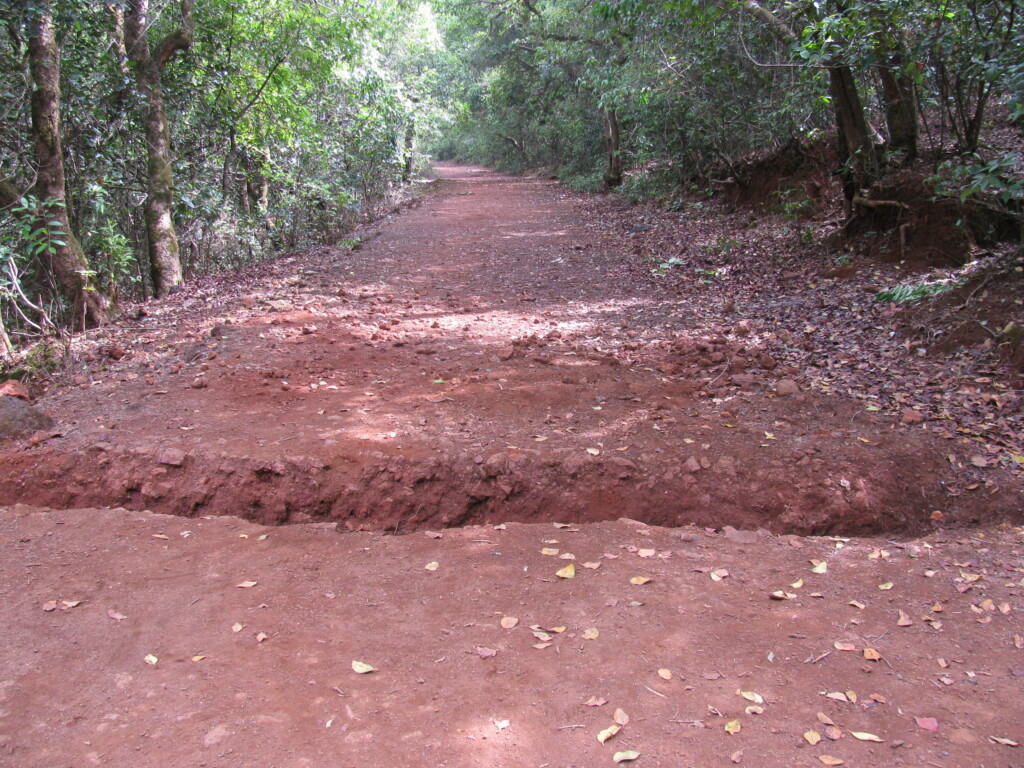
Provision of trenches across the entry point on all rides so as to provide access to only pedestrians and horses. Credit : David Cardoz
Consistent with the High Court order, the Government of Maharashtra framed regulations for the conservation of natural and man-made heritage sites in the region in 2001.
BEAG’S Ground-Breaking Writ Petition of 2002 (WP 7308/2002) converted to Public Interest Litigation (PIL 39/2003)
Despite the landmark court order in WP 2754, the Mahabaleshwar-Panchgani Region was once again reeling under the effects of rampant environmental and ecological damage.
Illegal construction was continuing unabated, putting an incredible strain on the environment, consuming scarce resources, and generating even more waste — waste that was neither being treated or managed but being callously discharged, unsegregated, into the region’s valley and lakes.
The vegetation on the Panchgani Tableland had deteriorated beyond belief as the area had practically become an amusement center overrun with shops and vehicles.
Meanwhile, the Heritage Committee under the Chairmanship of Shri Surve had deleted several historic structures from the Heritage List. In addition, despite Court orders for standing forests to be mapped to ensure their protection under the Forest Conservation Act,1988, forested areas were being subjected to rampant construction, causing immense damage to the Eco-Sensitive Zone (ESZ).
The issue of illegal constructions was particularly vexing. Many of the constructions identified as illegal by the Arun Bhatia Committee in 1997 had not been removed even five years after the committee had submitted its report. (The Arun Bhatia Committee had been appointed by the High Court in response to BEAG’s writ petition of 1997 (WP 2754/1997). Meanwhile, new permissions for repairs and renovations were being misused for new construction, and plots in residential areas had constructed more than one main structure per plot in violation of building bye-laws.
The issue of lack of solid waste management and sewage disposal was downright dangerous. As the Mahabaleshwar and Panchgani municipal councils had not set up sewage treatment plants and solid waste management facilities, despite the recommendations of the High Court Monitoring Committee, untreated effluents and solid waste were being discharged into the valley and the lakes. Panchgani did have a small sewage treatment plant but it did not have the capacity to handle the amount of waste being generated, with the result that unsegregated waste was still being dumped in a landfill site.
In response to BEAG’s writ petition (WP (WP 7308/2002), which later became a public interest litigation (PIL 39/2003), the Bombay High Court passed its final order on October 19, 2006, as follows:
On the issue of continuing Illegal constructions, the Court directed the Mahabaleshwar and Panchgani Municipal Councils to follow the existing building bye-laws strictly. The Court stated categorically that the bye-law requiring minimum plot size to be 0.4 hectares, equal to 1 acre, was applicable to all plots on the Mahabaleshwar Plateau, regardless of whether the plot housed a residential, educational, business, mercantile, or industrial building or assembly hall, and this requirement could be relaxed only in special cases after special approval had been obtained from the Urban Development Department.
The Court stated that for residential buildings, the maximum built-up area permissible was 12.5 percent, the maximum vertical expansion permissible was ground plus one, and the maximum floor-space index permissible was 0.15, and that the minimum space around the building should be no less than 6 meters. A plot could only have one building together with one out-house or garage consisting of a ground floor and a height restriction of 4.5 meters that could not be separately let out. When restoration work was being conducted on unsafe buildings, if the building had consumed less than the permissible FSI, it was allowed to use the full FSI but the external facade had to be as similar to the original structure as possible and in tune with the natural environment of the hill station.
On the issue of lack of solid waste and sewage treatment and management, the Court directed the Panchgani Municipal Council to upgrade its existing sewage treatment plant and set up two more sewage treatment plants.
It directed the Mahabaleshwar Municipal Council to set up two sewage treatment plants and a solid waste management facility within six months.
The Court ordered hoteliers and commercial institutions in Mahabaleshwar and Panchgani to have their own treatment facility by December-end 2006, and it directed the Maharashtra Pollution Board to check the effluents from these establishments in January 2007 and close those that did not meet the required effluent discharge standards. The Court warned the municipal councils that in the event the sewage treatment plants and solid waste management facility were not set up, the state government would take appropriate action, which could include superseding the municipal councils for failure to fulfill their essential obligations under the Maharashtra Municipal Councils, Nagar Panchayats and Industrial Townships Act of 1965.
On the issue of the degradation of the Panchgani Tableland, the Court noted that appropriate orders had already been passed in 2006 and it directed the Panchgani Municipal Council to implement them scrupulously.
On the issue of the deletion of heritage structures from the Heritage List by the Surve Committee, the Court noted that the deletions had already been corrected and it directed the municipal bodies and the state government to ensure that the heritage structures on the Heritage List were retained with their aesthetic value.
On the issue of the delay in mapping deemed forests, the Court directed that the mapping be completed by October-end 2006 and the marking of the forest on the land be completed by December-end 2006.
Contempt Petitions 189 and 190 of 2008
Although the Bombay High Court’s order of October 2006 had given the Mahabaleshwar and Panchgani Municipal Councils six months to implement its directives, even as late as 2008, the municipal councils had failed to do take action to set up STPs and SWMF. BEAG was therefore compelled to file separate Contempt of Court Petitions against the municipal councils.
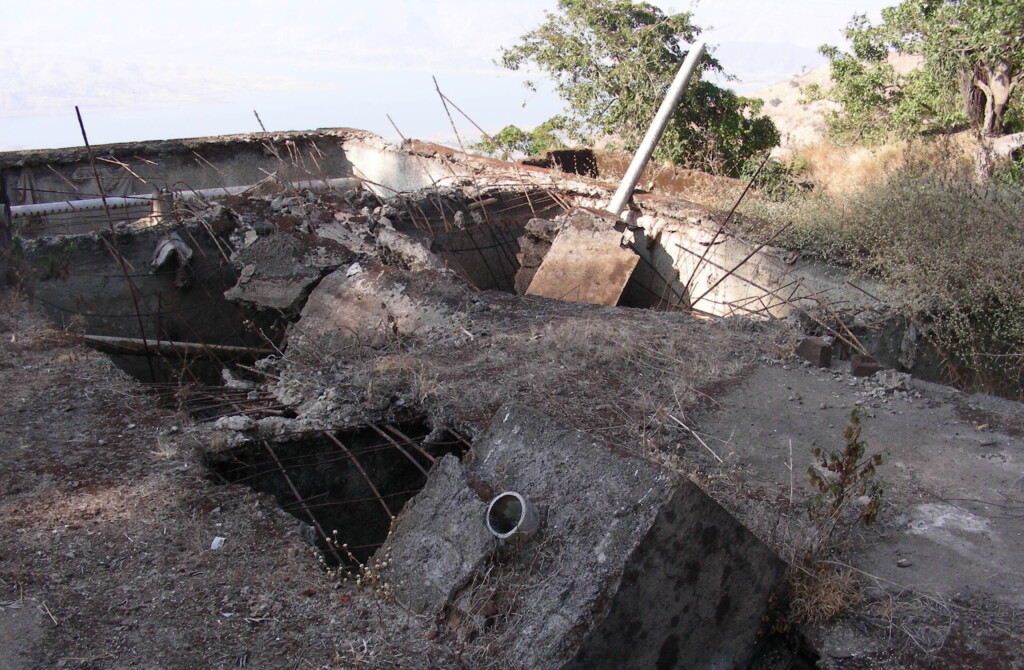
STP Next to Hindu Crematorium, Panchgani Municipal Council. Credit: BEAG Archive

STP at Shivaji Nagar, Panchgani Municipal Council. Credit: BEAG Archive
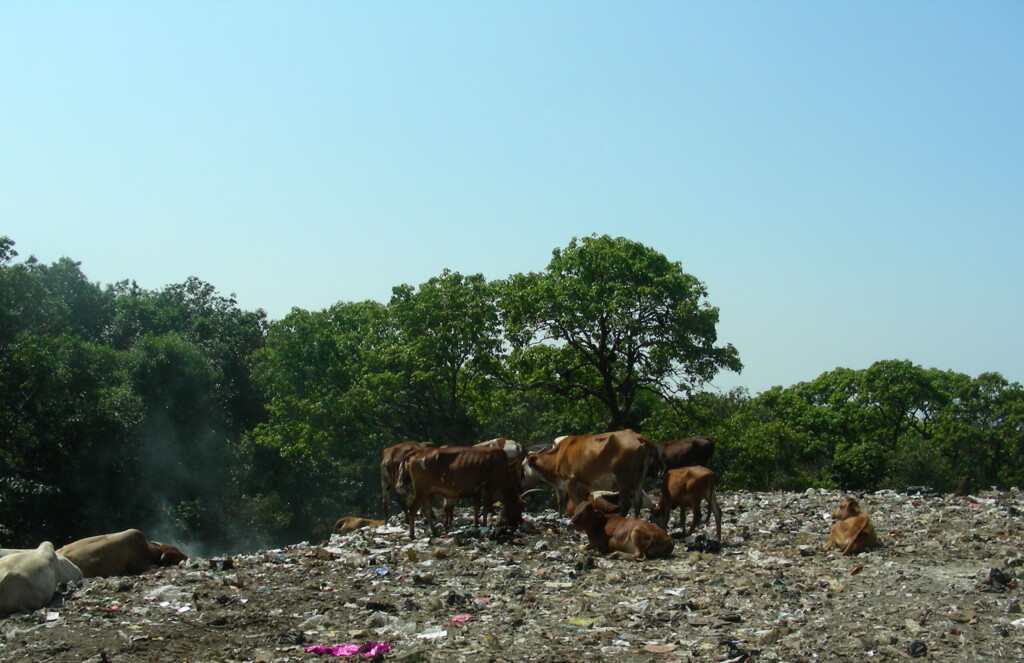
Unscientific Management of Solid Waste Facility by Mahabaleshwar Municipal Council on forest land. Credit: BEAG Archive
BEAG’s contempt petition against the Mahabaleshwar Municipal Council drew the Court’s attention to the fact that while the Mahabaleshwar Municipal Council had started construction of its first sewage treatment plant on a forest plot, the structure was itself in danger of collapsing due to heavy run-off of the soil below the plant’s foundation. Despite this, the Mahabaleshwar Municipal Council had ordered the laying of drain pipe connections to the sewage treatment plant, but realizing that the required slope was not appropriate, had once again dug up the entire length of the connections and re-laid pipes at a much lower level, causing sewage to flow everywhere.

STP at Karmchari Nagar, Mahabaleshwar Municipal Council. Credit: BEAG Archive
.
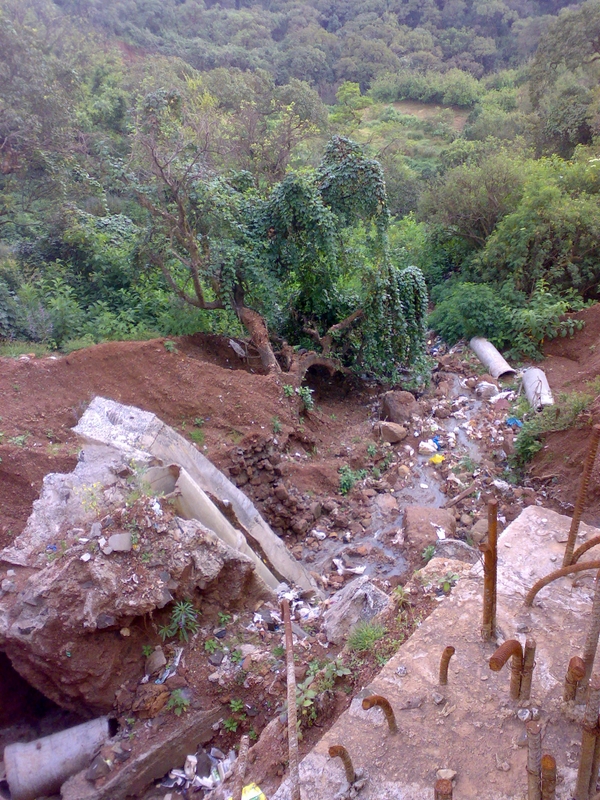
STP at Karmchari Nagar, Mahabaleshwar Municipal Council. Credit: BEAG Archive
.

STP at Karmchari Nagar, Mahabaleshwar Municipal Council. Credit: BEAG Archive
For its second sewage treatment plant, the Mahabaleshwar Municipal Council was considering private properties and part of a leasehold property belonging to an agro-based co-operative society, and when BEAG objected to the second sewage treatment plant being set up on a heavily forested plot, the Mahabaleshwar Municipal Council filed a writ petition against BEAG accusing it of obstruction. (The council’s writ petition was disposed of by the Bombay High Court.)
BEAG had recommended a few plots for the sewage treatment plant, but the Mahabaleshwar Municipal Council had refused to consider the sites, saying that it wanted to acquire a portion of a leasehold property belonging to the MSRTC for the second sewage treatment plant. Ultimately, the second sewage treatment plant was established on a plot at Dhobi Ghat that belonged to the Mahabaleshwar Municipal Council and the solid waste management facility was set up on a plot on the outskirts of Mahabaleshwar given by the Forest Department.
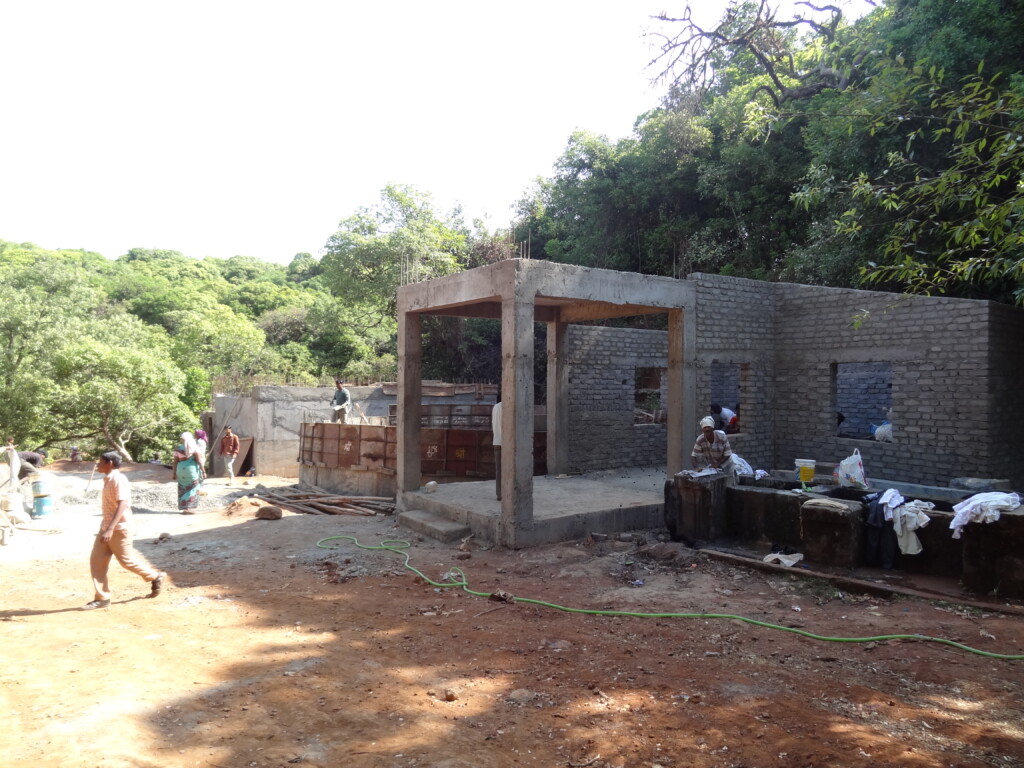
Second STP at Dhobighat, Mahabaleshwar Municipal Council under construction. Credit: BEAG Archive
.
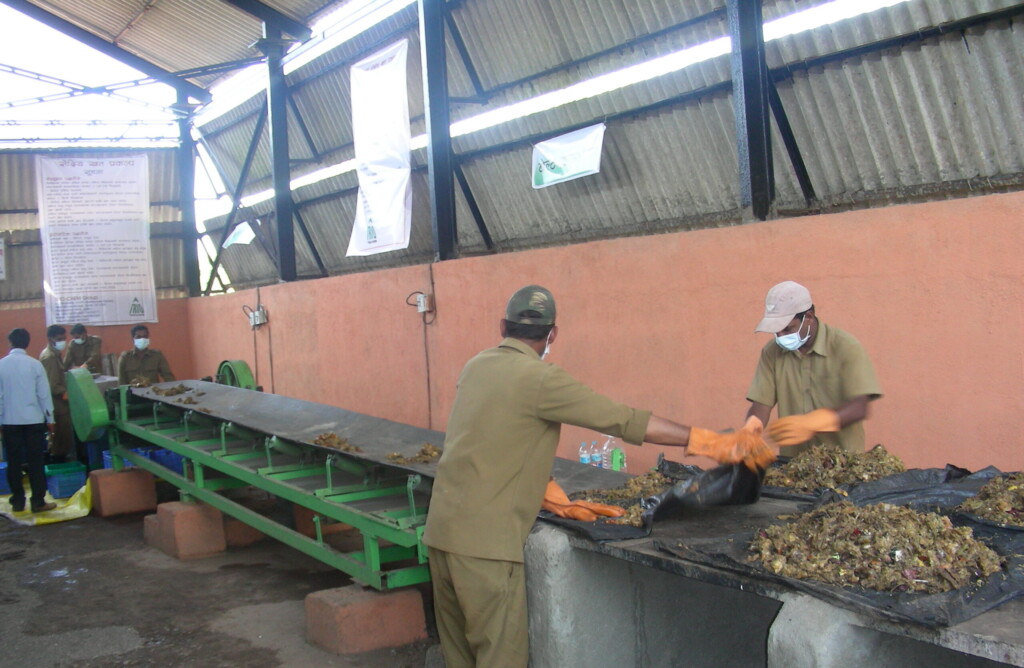
SWMF on the outskirts of forest land, Mahabaleshwar Municipal Council. Credit: BEAG Archive
BEAG’s contempt petition against the Panchgani Municipal Council pointed out that despite the High Court banning the use of horses and horse carts on the tableland, horses and horse carts continued to be plied all over the already damaged Tableland. BEAG’s petition noted that the Panchgani Municipal Council was not making any effort to control the use of horses and horse carts on the Tableland, nor to erect High Court Monitoring Committee-ordered barricades around the Tableland.
Situation Since the Petitions
Solid Waste and Sewage Treatment Plants
With both the Mahabaleshwar and Panchgani Municipal Councils delaying the implementation of the Court’s orders and clearly lacking the expertise to set up sewage treatment plants and solid waste management facilities, on BEAG’s request the High Court appointed NEERI as an expert to look into the issue of solid and liquid waste disposal not only for the two municipalities but for the entire region. MPCB report
By 2014, the Mahabaleshwar Municipal Council had finally set up one solid waste management unit and two sewage treatment plants with the help and expertise of NEERI, appointed by Bombay High Court on BEAG’s insistence.
Soon after BEAG’s Contempt Petitions of 2008, the Panchgani Municipal Council commenced the construction of its second sewage treatment plant, but inexplicably postponed the date of its commissioning. Even as late as 2010, the council had failed to connect sewage pipes to the new plant. Its existing sewage treatment plant, meanwhile, was on the verge of collapse due to poor maintenance and capacity overload, resulting in untreated sewage flowing into the valley.
Unfortunately, the functioning of the plants does not meet the required standard parameters, and the matter is still pending in court.
Panchgani Tableland
In its 1998 order in response to BEAG’s 1997 writ petition (WP 2754/1997), the High Court had directed the Mahabaleshwar Municipal Council and the Panchgani Municipal Council to ensure that no further construction would take place at the scenic Wilson Point in Mahabaleshwar and Sydney Point and Tableland in Panchgani.
However, despite the Court order, and under the garb of meeting the needs of tourists, various amusement activities had mushroomed on the Panchgani Tableland and motor vehicles were being freely driven across the entire area.


Amusement activities on Panchgani tableland. Credit: BEAG Archive
.

Horse carts and rides continue in monsoon despite the High Court ban. Credit: BEAG Archive
In 2002, BEAG once again filed a writ petition (WP 7308/2002 / PIL 39/2003) against the violations.
On June 11, 2004, the High Court Monitoring Committee (HCMC) finalized what came to be known as the HCMC plan for the preservation of the Panchgani Tableland after consulting with various stakeholders, including horse owners and horse cart owners.
The High Court on October 19, 2006, accepting the HLMC plan, passed its final judgment and order, permitting 20 acres on the southern portion of the main tableland to be used for horses, horse carts, parking and an interpretation centre, and reserving the rest of the tableland — 80 acres — for conservation and walkers only.
But in 2008, BEAG was forced to again file a contempt petition when it became clear that the High Court orders were being flagrantly and constantly violated, causing extreme damage to the fragile Tableland.
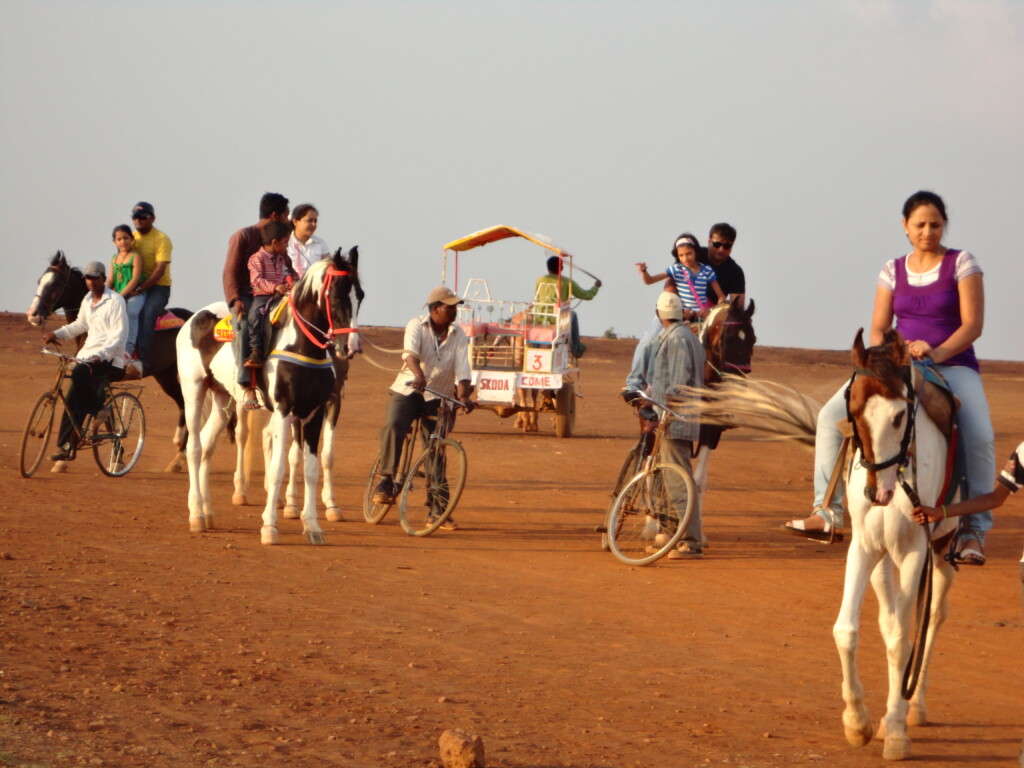
Horse riding handler bicycle carts banned activities on Panchgani tableland Credit: BEAG archive
.

Mud storm caused by plying of horsecarts Credit: BEAG Archive
.
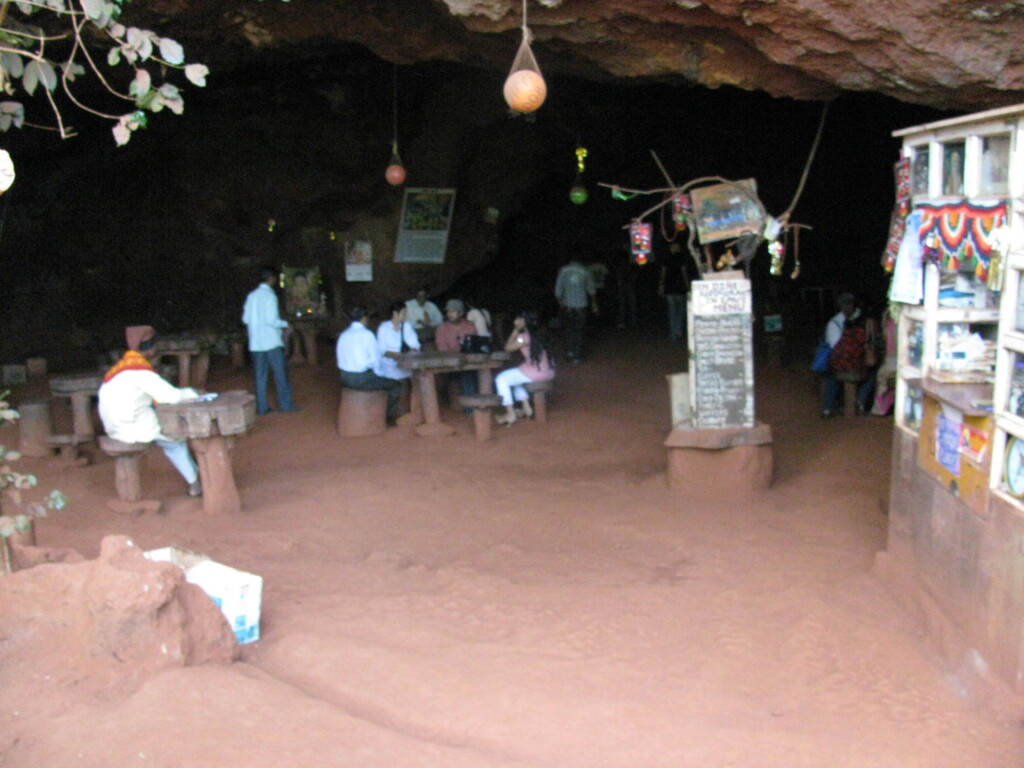
Restaurant in the bat cave below Panchgani Tableland. Credit: BEAG Archive
In 2012, a tragic horse-cart accident occurred on the Tableland that resulted in the death of a young girl and a horse. It was only after this accident that the municipal authorities finally took action to prevent horses and horse carts from plying on the Tableland. Press clippings
On May 4, 2012, after the High Court Order passed in response to BEAG’s 2008 contempt petition, the petitioners and respondents jointly visited the Tableland with a noted ecology expert, provided under the aegis of the Court, as well as animal welfare activists to study the effects of the plying of horses and horse carts on the Tableland.

Joint site visit of Dr. Aparna Watve along with stakeholders as per HC Order. Credit: BEAG Archive
Soon after, noted biome conservation expert Dr. Watve began a detailed year-long survey of the Tableland. In the survey report submitted to the Court, Dr Watve stated that the use of horse carts was not only preventing vegetation recovery of the Tableland but was further endangering its fragile ecology and biodiversity. The study concluded that only horse riding could be permitted.
The Panchgani Municipal Council also filed a brief report, based on the findings of botanist Dr. Salunke from a single day’s visit, but it too acknowledged that the Tableland had a unique and biodiverse vegetation that was being endangered and there was little possibility that vegetation in some areas, including the horse tracks, could ever recover.
On February 22, 2013, the Tableland Association filed a civil application (Civil Application No. 109 of 2013).
However, the civil application’s plea to ply horse carts on the main Tableland was dismissed on October 8, 2013, by the Bombay High Court, after taking into consideration the reports submitted by the Court-appointed ecologist Dr. Aparna Watve and an ecologist appointed by the Panchgani Hill Station Municipal Council, Dr. Chandrakant Salunke. But the Court noted that keeping in mind the interest of the horses and the horse cart owners, only horses would be permitted on an earmarked track on the main Tableland.

Continued efforts of BEAG along with HLMC Chairman Dr. Ankur Patwardhan to resolve the issue. Credit: BEAG Archive
Despite the unequivocal Court ruling, the Tableland Association filed yet another application on September 29, 2015, (Civil Application No. 20 of 2016).
On April 11, 2017, the Tableland Association’s application was dismissed.
With no recourse left in the Bombay High Court, in January 2018, the Tableland Association challenged the Court’s order of October 8, 2013, and of April 11, 2017, and filed a Special Leave Petition against the High Court Orders.
BEAG continued its battle to save Tableland’s fragile ecosystem, as another accident occurred in 2018 on the main Tableland when a man died after falling from a horse.
The matter finally reached the Supreme Court. On February 19, 2020, the Supreme Court gave its judgment upholding the orders of the Bombay High Court in restricting the use of horse carts to 20 acres of the Panchgani Tableland, and directing the Panchgani Municipal Council to set out a plan within six weeks for providing a leveled track for horse carts within the 20 acres demarcated for their use. The Supreme Court also stated that BEAG may assist the Panchgani Municipal Council in suggesting environmental-friendly means of livelihood for the horse cart owners. (Press clippings.) (Video)
Deemed Forest
The Supreme Court had defined the word ‘forest’ in its ruling on the Godavarman case in 1996 as all statutorily recognized forests, whether designated as reserved, protected or otherwise, irrespective of ownership or classification.
In Maharashtra, areas that are deemed forest are called ‘Vansadrushya’, literally visible forests or “forest-alike” areas in Marathi.
Mapping of Vansadrushya for MPESZ
In 1997, BEAG had implored the High Court in a writ petition (WP 2754/97) to ensure that the 1996 Supreme Court order be strictly implemented by the Government of Maharashtra in order to protect the forest area in and around Mahabaleshwar from further destruction and felling of trees.
In its ruling in 1998, the High Court constituted a High Court Monitoring Committee (HCMC) headed by the Deputy Conservator of Forests in Satara to monitor the development and construction activity within the Mahabaleshwar-Panchgani region so as to ensure that it was being carried out in accordance with the law. The HCMC was also given the important responsibility of assisting the Forest Department in surveying and demarcating forest lands in accordance with the directions laid down by the Supreme Court in its 1996 order.
However, the concerned authorities did not comply with the Court order regarding the survey and demarcation of forests, and BEAG had no option but to turn to the courts for help.
Writ Petition 7308/2002 converted into PIL 39/2003
In 2002, BEAG filed a writ petition (WP 7308/2002) that took up the issue of the mapping of the Vansadrushya.
In response to the petition, the High Court passed several orders directing the Revenue Department and the Forest Department to survey and demarcate forest lands in accordance with the 1996 directives of the Supreme Court and to comply with the 1998 directives of the High Court of Bombay in response to the writ petition filed by BEAG in 1997 (WP 2754/1997).

Vansadrushya map of leasehold property at Mahabaleshwar Municipal Council. Credit: BEAG Archive
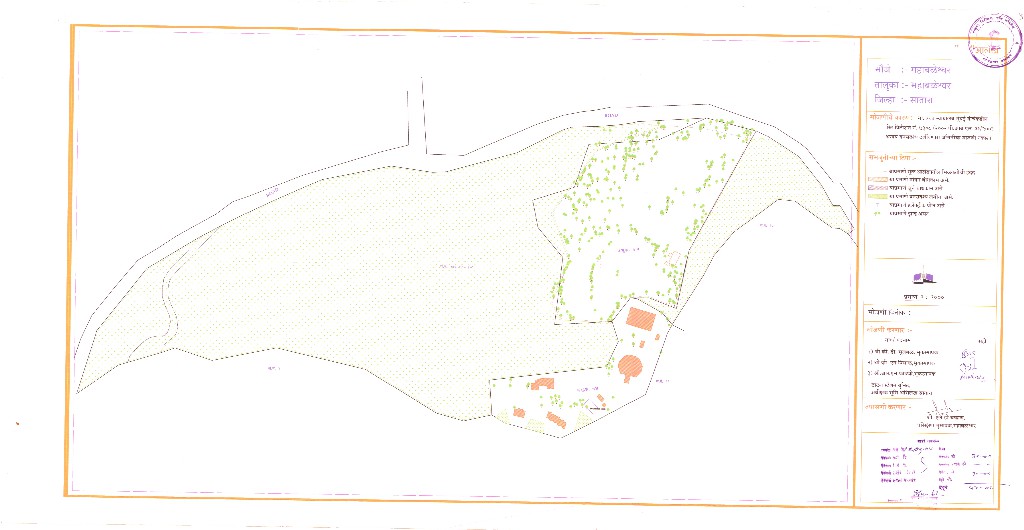
Vansadrushya map of Freehold property at Mahabaleshwar Municipal Council. Credit: BEAG Archive
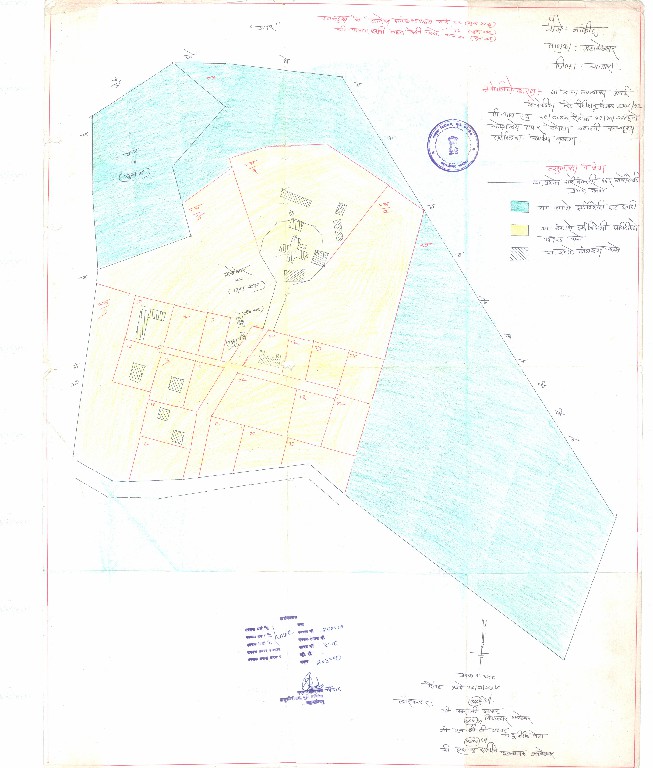
Vansadrushya map of Village areas in MPESZ. Credit: BEAG Archive
In October 2006, the High Court directed the Government of Maharashtra to complete the forest -survey process by the end of October 2006 and the forest-demarcation process by December 2006.
In January 2007, the Government of Maharashtra requested the High Court for additional time to complete the mapping and demarcation of forest areas. The request was granted.
In March 2007, the Government of Maharashtra completed its mapping of the Vansadrushya.and submitted the Report to the High Court.
After seeking approval from the Ministry of Environment, Forest and Climate Change as mandated by the ESZ notification, the Government of Maharashtra published the final Mahabaleshwar and Panchgani Regional SZMP.
In its final notification dated August 7, 2015, the Government of Maharashtra taking cognizance of the mapping stated the following:
- The physical survey maps would be verified by satellite imagery and the details of the mapped ‘forest-alike’ areas would be available for public access on the Government of Maharashtra website.
- Detailed maps for the entire region showing ‘forest-alike’ areas, wherever these occur in individual survey numbers, were available with the Taluka Inspector of Land Records in Mahabaleshwar. These ‘forest-alike’ survey maps would be part of the Zonal Master Plan for the region and the Development Plans (SZMPs) for the municipal council areas of Mahabaleshwar and Panchgani.
National Green Tribunal
Despite the 2006 Court order and the Government of Maharashtra’s final notification in August 2015 recognizing the forest survey mandated by the High Court, the High Level Monitoring Committee (HLMC), then chaired by Shri Karandikar, questioned the legal validity of the survey and mapping of the ‘forest-alike’ areas.
In its February 2016 meeting, an HLMC sub-committee claimed that the provisions for ‘forest-alike’ areas appeared to lack legal validity and hence needed to be reconsidered by the Government of Maharashtra. It exhorted the state government to determine the objective and verifiable criteria for defining lands as ‘forest-alike’ and to undertake a fresh survey of the ‘forest-alike’ areas based on such objective criteria. The HLMC sub-committee concluded that it would be improper to make any provision in the Regional Plan for ‘forest-alike’ areas, and even more impudently, requested the Ministry of Environment, Forest and Climate Change to ask the Government of Maharashtra to keep its August 2015 notification in abeyance.
Meanwhile, the situation on the ground had become even more serious as unauthorized and illegal constructions in Vansadrushya areas continued unimpeded, in complete violation of the Forest (Conservation) Act of 1980.
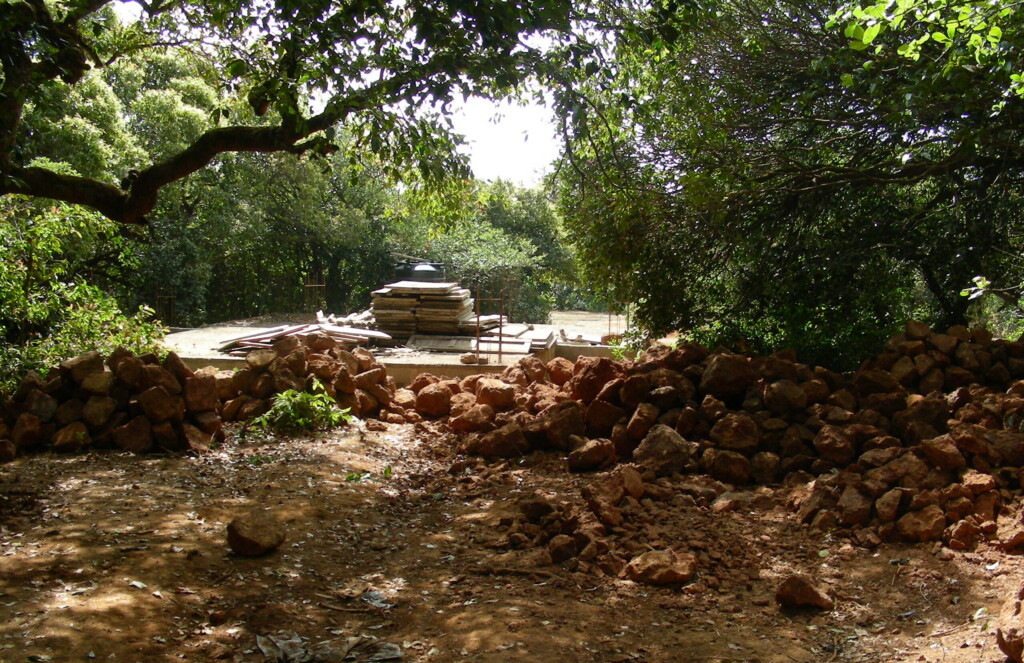
Unauthorized and illegal constructions in Vansadrushya areas in complete violation of the Forest (Conservation) Act of 1980. Credit: BEAG Archive
In 2016, BEAG was compelled to file an application in the National Green Tribunal (NGT) against the destruction of Vansadrushya areas, requesting inclusion of the areas in the Regional Plan and the Development Plans of Mahabaleshwar and Panchgani.
On September 8, 2016, the Tribunal ruled to restrain all non-forest activity in the Vansadrushya in the Mahabaleshwar-Panchgani ESZ, stating that non-forest activity was violative of the Forest (Conservation) Act of 1980. The Tribunal also barred tree-felling, new development, and construction activity in the Vansadrushya.
The Municipal Councils of Mahabaleshwar and Panchgani and the Satara District Collector’s Office failed to submit statements about the violations in Vansadrushya areas and the actions they had taken against the violations.
BEAG continued to file rejoinders countering the contradictory, inconsistent, and partial statements being made in the submissions of the Mahabaleshwar and Panchgani Municipal Councils and the Satara District Collector’s Office.
Finally, in November 2016, the Tribunal levied a fine of Rs 5,000 on the Forest Department for failure to file required statements. The Tribunal also summoned the Deputy Director of the Pune Land Records Division to provide clarification on whether the mapping had been carried out in accordance with the High Court order of 2003.
On March 2017, the Tribunal directed the Ministry of Environment, Forest and Climate Change, the District Collector of Satara, the Mahabaleshwar Hill Station Municipal Council, the Panchgani Hill Station Municipal Council, the District Forest Officer, the Town Planning Department, and the Deputy Superintendent Land Records of Satara, to hold a meeting on April 6 and 7, 2017, to identify the areas where violations of the Forest (Conservation) Act of 1980 had taken place with reference to the maps of the ESZ and to chalk out an action plan for enforcing the provisions of the Forest (Conservation) Act of 1980.
Once again, partial statements were submitted by the agencies. The Wai Sub Divisional Officer, acting on behalf of the Satara District Collector, went so far as to challenge the mapping itself.
In February 2018, due to the fact that the NGT, Western Zone Bench, Pune, had not been reconstituted and the Ministry of Environment, Forest and Climate Change had brought out a notification conferring jurisdiction of all Zonal Benches on the Principal Bench, New Delhi, the matter was transferred to the NGT Principal Bench, Delhi.
In May 2018, the Tribunal observed that the submissions that had been made by the agencies had not only failed to resolve the issue but had created even more ambiguity. The Tribunal directed the Satara District Collector and the Sub Divisional Officer of Wai to issue warrants against every violator who had been issued notices for violations, warning that it would hold the Wai Sub Divisional Officer and the Satara District Collector responsible for any lapse.
In October 2018, the Tribunal observed that once it passed its judgments in the original applications for adjudication on violations in Vansadrushya, the violations could be addressed by the concerned authorities.
In March 2019, the Tribunal ordered the constitution of a Joint Committee comprising of representatives of the Chief Conservator of Forests of Kolhapur and the Divisional Commissioner of Pune to look into the violations and submit a report within three months. The Pune Divisional Commissioner authorized the Wai Sub Divisional Officer as his representative at the committee, while the Kolhapur Chief Conservator of Forests authorized the Satara Assistant Conservator of Forests to be his representative.
BEAG sent a representation to the joint committee with the entire facts of the petition. It also drew attention to a new violation: the ongoing destruction of the Vansadrushya near the Panchganga Temple to make room for unauthorized construction and the failure of the concerned authorities to address the complaints of the local people.
The Joint Committee submitted its report in August 2019.
BEAG challenged the Joint Committee report on several grounds: for not being in consonance with the High Court Order of March 2019; for containing contradictory observations by the concerned authorities; for not providing analysis or conclusions; and for considering only the complaints it had received and failing to conduct its own survey, leading to a number of violations not being included. BEAG also noted that the authorities had failed to take action against violators despite the March 2019 order to specifically look into the violations of the Panchganga felling of Vansadrushya areas.
Taking cognizance of BEAG’s challenge, the Tribunal observed on December 3, 2019, that despite its order of prohibition dated September 8, 2016, there appeared to be a relentless effort on the part of the authorities to delay the process, giving fillip and encouragement to violators.
The Tribunal directed the Mahabaleshwar Hill Station Municipal Council, the Panchgani Hill Station Municipal Council, the Satara District Collector and the Chief Conservator of Forest in Kolhapur to file a report showing the following: the number of cases filed under Section 2 of the Forest (Conservation) Act, 1980 against those in violation of the said law, the number of structures that existed in the declared ESZ prior to its notification, and the action that had been taken against the structures that had come up in violation of the Forest (Conservation) Act, 1980, and the ESZ Notification.
The matter is now listed for hearing on April 1, 2020, and is being actively pursued by BEAG.
Heritage
Along with its natural heritage, Mahabaleshwar and Panchgani have a large number of heritage structures and precincts.

Listed heritage property, Mahabaleshwar Municipal Council. Credit: BEAG Archive
.
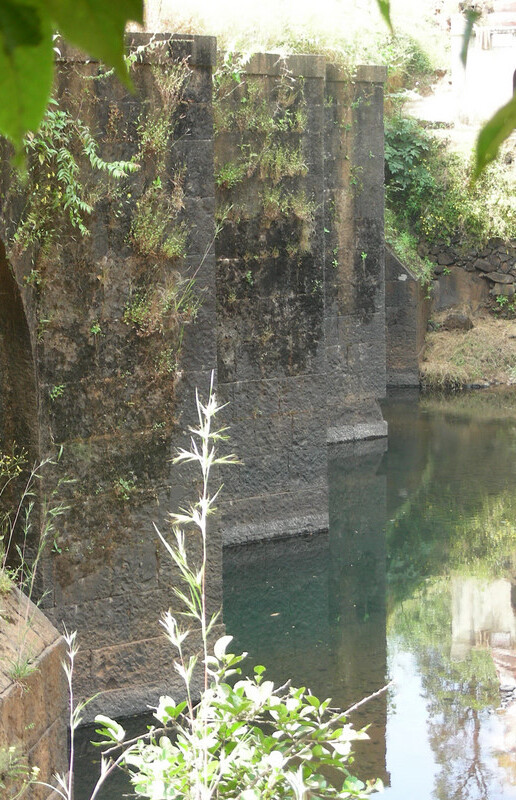
Bridge at Par village Credit: BEAG Archive
.
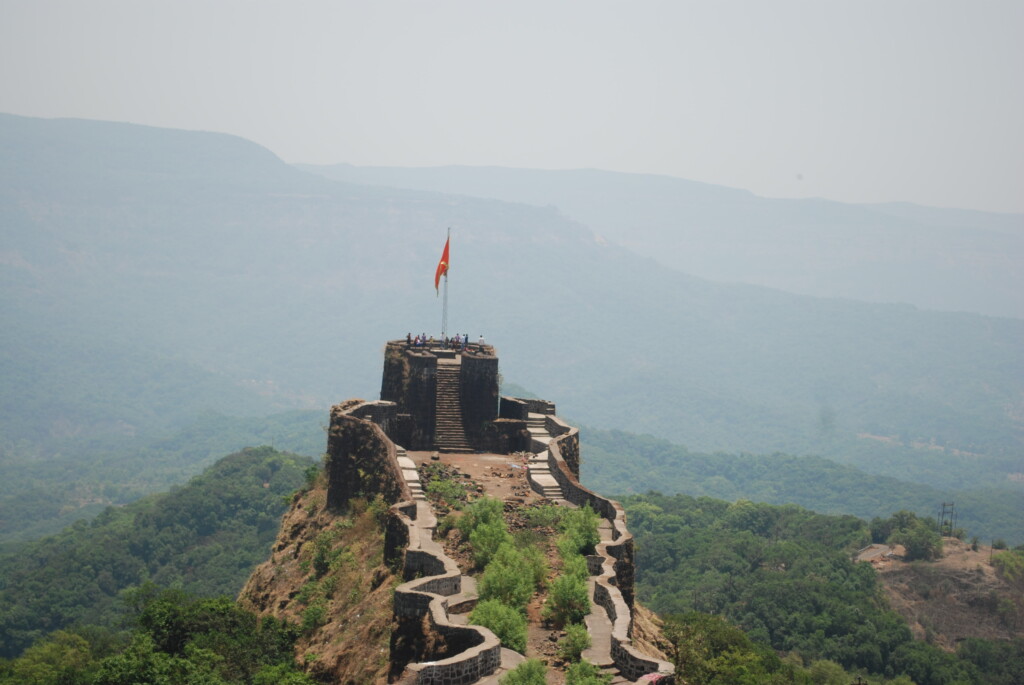
Pratapgad Fort. Credit: BEAG Archive
By 1996, Mahabaleshwar had become crowded, its bazaar taken over by loud music, gaming arcades, hawkers and shops that had brazenly extended their premises onto the road, leaving little space for pedestrians. Several multi-storey buildings had come up and more were under construction, although the prevailing law — the Development Plan of 1983 — allowed only ground plus one storey.


In 1997, BEAG filed a writ petition (WP 2754/1997) in the Bombay High Court seeking demolition of the illegal constructions that had come up in violation of the Mahabaleshwar and Panchgani Regional Plan (1984-2001), which states that leases can be granted on condition that the green cover is protected and no additional construction occurs. BEAG’s petition also urged the Court that the forest area in and around Mahabaleshwar be protected from tree-felling and encroachment.
In a subsequent hearing in March 1998, the BEAG counsel drew the Court’s attention to the MRTP Act amendments that provide for heritage conservation and preservation.
In response, the High Court directed the Government of Maharashtra to constitute a Heritage Conservation Committee.
The Government of Maharashtra assured the Court that it would constitute a Heritage Conservation Committee in one month, but it was only after a legal notice was served that the Government of Maharashtra finally constituted the committee in July 1998.
Thus, the first Heritage Conservation Committee (HCC) for the Mahabaleshwar Panchgani Region was constituted on July 21,1998, under the chairmanship of Shri Ravindra Surve, a retired IAS officer.
It was the first time in India that a HCC had been constituted for a statutorily designated region (consisting of the Mahabaleshwar and Panchgani municipal areas as well as rural areas outside these municipal limits), as opposed to a single municipal area.
Heritage Lists
In its final order in November 1998, the High Court had directed the Heritage Committee to formulate and finalize two important documents — the Heritage Lists for the towns of Mahabaleshwar and Panchgani and the region including both natural and man-made sites, and the Heritage Regulations for the region. These were to be prepared within four months in conformity with the Government of India’s Model Draft Heritage Regulation. The High Court directed the Government of Maharashtra to notify these documents within one month of receiving them.
Not wanting to leave the matter to the newly-constituted committee, BEAG commissioned heritage experts to prepare the Heritage Lists for the region as well as the towns of Mahabaleshwar and Panchgani. The lists prepared by the experts contained 253 sites — 131 in Mahabaleshwar, 87 in Panchgani, and 38 in the non-municipal areas. The Heritage Committee approved the lists almost in their entirety. On July 23, 2001, the draft lists along with the regulations were officially notified.
However, BEAG discovered that 92 sites that had been in the list approved by the Heritage Committee were missing from the lists that had been notified. BEAG was told that the Director of Town Planning had deleted the sites from the notified list.
As some extremely important sites, including Mount Malcolm, one of the earliest buildings in Mahableshwar, were among those that had been deleted, BEAG took the matter up with the Government of Maharashtra in November 2001.
A month later, the government issued instructions to reinstate the 92 deleted sites in the notified Heritage Lists.
However, the Mahabaleshwar Municipal Corporation recommended the deletion of 35 sites, a third of which were privately-owned properties and many of which were fine historical structures. The municipal corporation also wanted all the points, walks and rides to be downgraded from Grade I to Grade III. Grade I sites are given maximum protection and are not allowed to be modified.
BEAG raised these issues with the Monitoring Committee, then under the chairmanship of Shri Kanga, and also challenged them in court in 2003.
In response to BEAG’s writ petition (WP 7308/2002 converted to PIL 39/2003), the Bombay High Court on March 24, 2004, put a stay on the deletions, restraining the Satara District Collector and the Municipal Councils of Mahabaleshwar and Panchgani from granting development permissions other than those compliant with the notified draft Heritage Regulations and the full notified Heritage Lists.
The Final Heritage Lists along with the regulations were published as follows: Panchgani Municipal Council on January 9, 2013 Mahabaleshwar Municipal Council on October 29, 2015 and MPESZ Region on November 6, 2015.
Heritage Regulations
As directed by the High Court in its November 1998 order, the Heritage Conservation Committee formulated the Heritage Regulations for the region, which BEAG had helped amend in order to remove “several” lacunae such as responsibilities of the concerned authorities. The Draft Heritage Regulations were notified on July 23, 2001, the same day as the Heritage Lists.
The final Heritage Regulations, along with the Heritage Lists, were published as follows: Panchgani Municipal Council on January 9, 2013 , Mahabaleshwar Municipal Council on October 29, 2015, and MPESZ Region on November 6, 2015.
However, BEAG’s detailed scrutiny of the final Heritage Regulations for Mahabaleshwar, Panchgani, Municipal Councils, and MPESZ Region revealed several omissions compared with the heritage regulations of Satara and Wai — omissions that would reduce the new regulations to a mere paper tiger.
The HCC directed the Town Planning Department to forward the draft containing the corrections to the municipal councils, and directed the municipal councils to study and consider the document. Before any resolution is passed by the General Body of Mahabaleshwar & Panchgani a meeting with the Joint Director of Town Planning, Pune, has been mandated.
BEAG prepared a detailed document containing the various discrepancies. The document was discussed at the HCC meeting held on September 13, 2019, and the HCC approved the corrections. The changes will now be sent to the Government of Maharashtra for its approval.
BEAG continues to pursue the matter.
Heritage Conservation Committee (HCC)
The first HCC, for the period 1998 to 1999, was constituted under the chairmanship of Shri Ravindra Surve and a report was submitted to the UDD.
The second HCC, for the period 2008 to 2011, was constituted under the chairmanship of Shri V.R. Ranganathan. On January 16, 2010, the jurisdiction of the committee was extended to the municipal towns of Satara and Wai. The committee held 10 meetings.
The third HCC, for the period 2016 to 2018, was constituted under the chairmanship of Shri Dilip Bund. The committee held 6 meetings.
The fourth HCC for the period 2018 to 2021 is constituted under the chairmanship of Shri Dilip Bund. The committee held 3 meetings.
Christ Church In Mahableshwar
Christ Church is one of the oldest and most beautiful buildings in Mahableshwar and is a listed heritage structure.
Until BEAG’s intervention in 1996, the church was being used as a carpentry workshop by a former president of the Mahabaleshwar Municipal Council.
 |
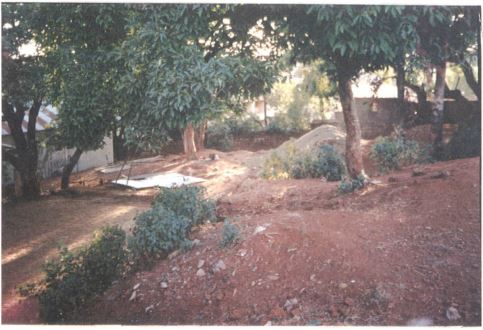 |
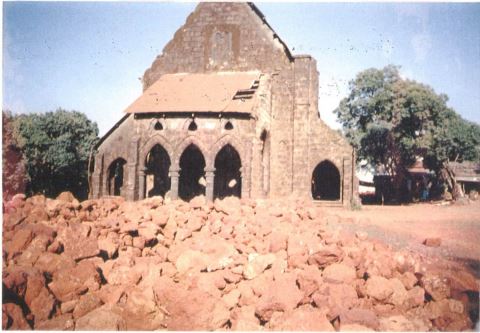 |
|---|---|---|
| Shed Encroachment in Church Property. Credit: BEAG Archive | Well Dug in Church Property. Credit: BEAG Archive | The construction material within the Church Compound. Credit: BEAG Archive |
After BEAG’s intervention, the encroacher moved out. The church was restored and once again became a living church. At one of its services, the Governor of Maharashtra presided as the chief guest.
However, in 2004, illegal construction of a Hindu temple started in a part of the church compound.
BEAG objected to the concerned authorities and the work was stopped then, but it started again a year later. BEAG protested again, and again the construction stopped.
However, in 2015, a wax museum started to come up on the site. Again BEAG objected, and sent representations to the Satara District Collector, to the Chief Officer of the Mahableshwar Municipal Council, and to the High Court Monitoring Committee.

Unauthorized wax museum in Christ Church. Credit: BEAG Archive
But the Mahabaleshwar Municipal Council has resisted initiating action against unauthorized construction, as it has been undertaken by the wife of an ex-president of the Municipal Council who had earlier on in 1996 encroached on the property.
BEAG’s persistent follow-up did lead to the Mahabaleshwar Municipal Council initiating action against the encroacher in 2016, but the encroacher challenged the Council’s action in the Trial Court and later at the Appellate Court, both of which ruled in favour of the Mahabaleshwar Municipal Council as there was no material on record to prove that the encroacher had any right to the property.
The Appellate Court order was challenged in the Bombay High Court, and in May 2018 the Court again ruled in favour of the Mahabaleshwar Municipal Council and dismissed the petition of the encroacher.
The HLMC and HCC for MPESZ have taken cognizance of this fact and have instructed the Chief Officer of Mahabaleshwar to initiate action against the encroachment.
In December 2018, all unauthorized constructions in the Christ Church compound had finally been demolished.
BEAG continues imploring concerned authorities to initiate action against all unauthorized structures, commercial activities and parking within heritage sites that do not have the requisite
Polo Ground
In February 2016, a Mumbai newspaper revealed that the state Forest Department was trying to reinstate the sport of polo in Mahabaleshwar, apparently to satisfy the Governor’s wish to bring back the glory days of polo during the British Raj. To this end, the Forest Department had requested the Forest Advisory Committee (FAC) to grant 3.67 hectares of protected forest land in the village of Malcolm Peth in Mahabaleshwar to the Satara Sport Authority for a polo ground.
BEAG was alarmed at the news. Not only was the whole of Mahabaleshwar an eco-sensitive zone, but the particular site in Malcolm Peth that had been declared a Grade 1 natural heritage site in the Final Heritage List of the Mahabaleshwar Municipal Council by the Govt. of Maharashtra. The polo project was violative of the ESZ notification and heritage conservation laws.
On close scrutiny of the polo project, BEAG concluded that the polo project was indeed environmentally unsound and ecologically destructive. As the British had themselves stopped all equestrian activity in the area during World War II, the soil of the British polo ground had settled over time and was now covered by an established eco-system of native herbs and grasses. The former British polo ground was a verdant grassland surrounded by jungles rich in bird life, visited by wild animals, and a nesting habitat for the giant squirrel, Maharashtra’s state animal.
BEAG anticipated that for this development, even more forests would be destroyed in order to provide infrastructure such as stables and roads for polo. And, what of the Draft Tourism Master Plan that had clearly stated that the carrying capacity of Mahabaleshwar town had already been well exceeded? Why had no environmental impact analysis study been conducted?
BEAG immediately started a correspondence with state government officials. It soon became clear that the government was in fact planning to expand the ground to two more hectares of forests for various ancillary facilities. The plan was to severely disturb the soil on the two additional hectares and lay an artificial layer, 6 inches deep, of “red clay over it and to develop green grass”, for which an estimated 350 truckloads of external soil would need to be trucked in. State government officials revealed that the polo project was to be executed on a war footing.
BEAG was even more concerned now. Apart from the actual serious destructive impact on the existing compacted ground, there would be tremendous disturbance and dust and diesel pollution due to the movement of trucks and heavy equipment. In addition, as the polo ground is slightly raised on some sides from the surrounding ground, the loose new soil will encourage erosion and run-off.
BEAG made a detailed representation to the High-Level Monitoring Committee (HLMC) against the environmentally destructive proposal. The HLMC, then chaired by Shri. Karandikar, noted that it had not received the proposal for approval and “the question of granting provisional approval by the present HLMC on ‘ad hoc’ basis does not arise because no definite and formal proposal has been placed before HLMC’.
BEAG next filed various Right to Information (RTI) requests with several authorities for further information, and after collating the information received under RTI, took the matter to the Heritage Conservation Committee (HCC). Based on BEAG’s representation, the HCC decided to have its chairman send a written request to the Director of Town Planning in Pune asking him to reconsider the permission given by that department during the HCC’s absence.
After persistent follow-ups with the state Forest Department and the central government against the handing over of the polo ground to the Satara Sports Authority, BEAG was relieved when the Ministry of Environment and Forests finally rejected the polo ground project on September 19, 2017.
BEAG continues imploring concerned authorities to initiate action against all unauthorized structures, commercial activities and parking within heritage sites that do not have the requisite permissions.






